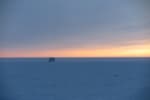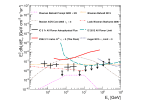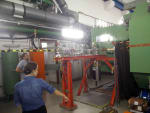With the sun now up, outdoor preparations for summer activity at the South Pole station will move into higher gear. Calm weather last week provided an opportunity to groom the skiway, shown in this image, where the Earth’s shadow is still visible in the sky as a blue band just above the horizon. […]
News
IceCube graduate student Seongjin In awarded the Korean Global PhD Fellowship
The National Research Foundation of Korea has awarded Seongjin In, a graduate student at Sungkyunkwan University (SKKU) and known as Jin within the IceCube community, with a 2015 Global PhD Fellowship (GPF). […]
Week 37 at the Pole
Sunrise is slowly coming along at the South Pole, with some refracted light showing over the horizon on clear days. The impending orange glow appears to be approaching the ICL in this image. […]
A summer of Antarctic research at UWRF
The Physics Department of UW–River Falls hosts summer internships for young college students that allow them to engage in IceCube and other polar science projects. Over the 10-week internship, they become a member of the team, where they learn to program and to tackle challenging scientific questions. And, as you will read here, they also get a chance to share their experience. […]
The tau neutrino hunt is now in full swing
Today the IceCube Collaboration has presented a search for tau neutrinos at energies above 214 TeV that, although it did not find any events, allowed setting upper limits on the astrophysical tau neutrino flux. This search sets limits on tau neutrinos at energies three orders of magnitude lower than the energies reached by previous dedicated tau neutrino searches. And more importantly, the results now submitted to Physical Review D also prove that tau neutrino searches in IceCube are reaching the sensitivity for a potential discovery. […]
Week 36 at the Pole
The landscape at the South Pole continues to brighten, making it perhaps harder to ignore the extent of snow accumulation at the IceCube Lab. But snow removal wasn’t on the table last week, which was a quiet one all around for the IceCube winterovers. […]
Search for transient astrophysical neutrino emission using GeV muon neutrinos in IceCube
In a paper submitted today to the Astrophysical Journal, the IceCube Collaboration presents results of a search for astrophysical sources of transient neutrino emission using a sample of low-energy—30 to 300 GeV—muon neutrino events from DeepCore. Although no source is singled out, the study sets limits on soft-spectra models, such as energetic or nearby choked GRBs. […]
Week 35 at the Pole
Although the sunrise is still not officially here, the South Pole is enjoying a period of twilight. The horizon is clearly visible in the direction of the sun and is showing some characteristic orange color. The photo shows this nicely, with the added effect that reflection in the station windows gives the appearance of a clear view through the windows of the continuous horizon. […]
Our summer research experience working on PINGU with researchers at Universität Mainz
The “IRES: U.S.-European International Research Experience-Particle Astrophysics for Undergraduates” program, funded by NSF and led by the University of Wisconsin–River Falls, brought us to Johannes Gutenburg University in Mainz, Germany, this summer to work with Professor Lutz Köpke and Professor Sebastian Böser. […]
Francis Halzen wins 2015 Balzan Prize
Francis Halzen, IceCube principal investigator and Hilldale and Gregory Breit Distinguished Professor at the University of Wisconsin–Madison, was announced yesterday as one of the prestigious international 2015 Balzan prizewinners. […]









